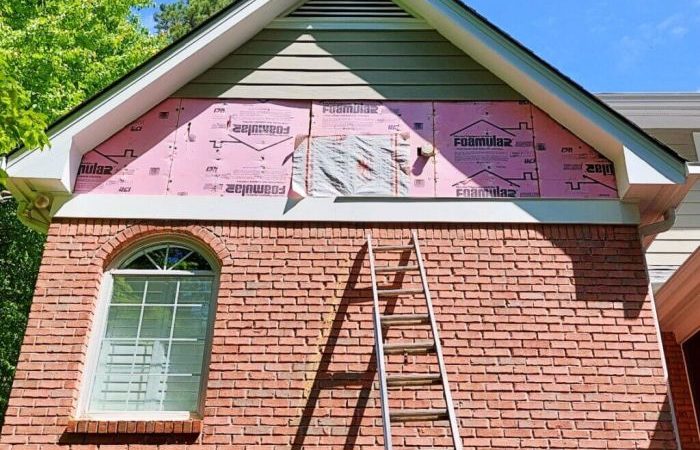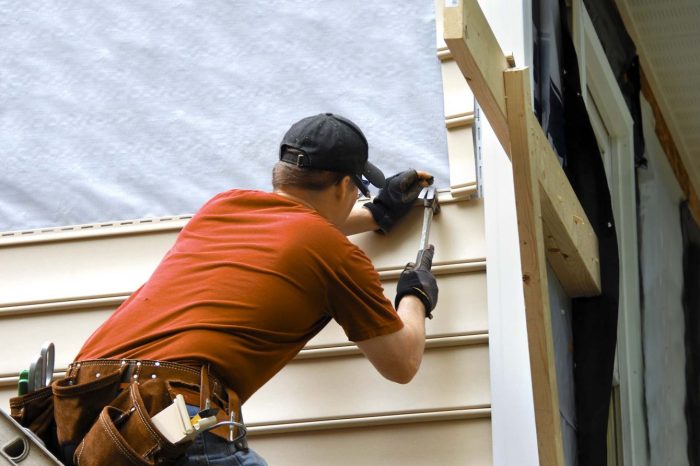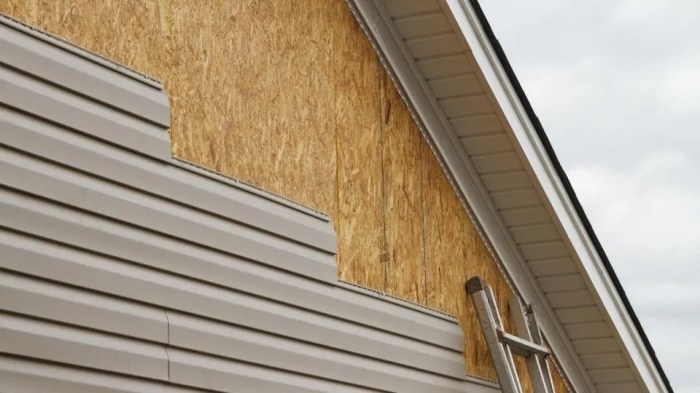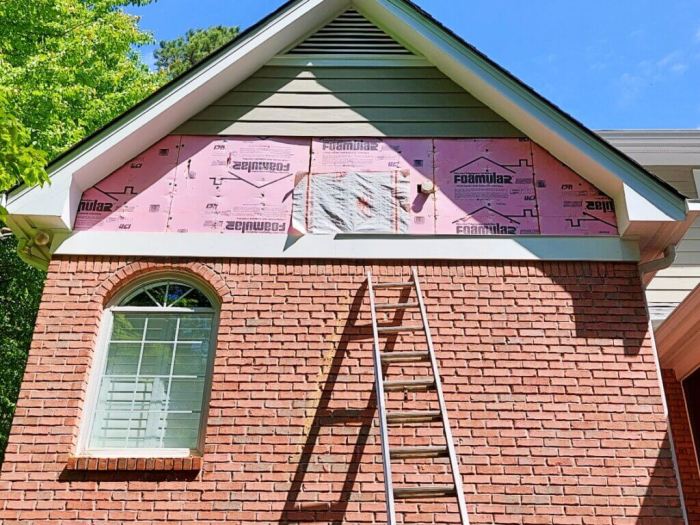Vinyl Siding Repair Contractors Near Me

Vinyl siding repair contractors near me: Finding the right person for the job can save you time, money, and headaches. This guide walks you through everything you need to know, from understanding the common problems with vinyl siding to choosing a reputable contractor and ensuring a smooth repair process. We’ll cover everything from pricing and warranties to asking the right questions and recognizing quality workmanship. Get ready to transform your home’s exterior!
Whether you’re dealing with cracked panels, discoloration, or storm damage, a professional repair can significantly improve your home’s curb appeal and protect it from further damage. This guide will empower you to make informed decisions and find a contractor who meets your needs and budget.
Understanding Local Market Demand: Vinyl Siding Repair Contractors Near Me
Understanding the local market for vinyl siding repair is crucial for success. This involves identifying common problems, understanding your ideal customer, and developing a competitive pricing strategy. By analyzing these factors, contractors can effectively target their marketing efforts and maximize profitability.
Common Vinyl Siding Issues Across Climates
Different climates present unique challenges to vinyl siding. For example, extreme temperature fluctuations, common in many parts of North America, can lead to expansion and contraction, causing cracks and warping. Coastal areas experience high humidity and salt spray, accelerating degradation and leading to discoloration and premature failure. Areas with heavy snowfall can see damage from ice buildup and snow loads, resulting in broken or damaged panels.
The Typical Homeowner Seeking Vinyl Siding Repair
The typical homeowner seeking vinyl siding repair is often a homeowner of a property that is 10-20 years old. They might be concerned about the appearance of their home, noticing fading, discoloration, or damage from storms. They are likely looking for a reliable and reasonably priced solution to restore the curb appeal and protect their home’s exterior. Some homeowners might be preparing their home for sale, while others simply want to maintain the value of their investment. These homeowners prioritize quality workmanship, a clear understanding of costs, and timely completion of the project.
Pricing Strategies of Vinyl Siding Repair Contractors
Three hypothetical contractors might employ different pricing strategies. Each strategy caters to a different segment of the market.
Average Cost of Common Vinyl Siding Repairs
| Repair Type | Average Cost (USD) | Factors Affecting Cost | Additional Notes |
|---|---|---|---|
| Single Panel Replacement | $50 – $150 | Size of panel, material cost, labor | Cost increases with difficult access or extensive prep work. |
| Repairing Small Cracks | $25 – $75 per crack | Severity of crack, material used for repair | Caulking or patching may be sufficient for minor cracks. |
| Section Replacement (multiple panels) | $200 – $1000+ | Extent of damage, material cost, labor | Larger areas require more time and materials. |
| Full Siding Replacement | $5000 – $20000+ | House size, material choice, complexity of installation | This is a significant investment, but can greatly enhance home value. |
Contractor Profile & Services
Choosing the right vinyl siding repair contractor is crucial for a successful project. A reputable contractor possesses a blend of skills, experience, and certifications that ensure quality workmanship and customer satisfaction. Understanding their profile and the services offered is key to making an informed decision.
Contractor Qualifications and Certifications
Reputable vinyl siding repair contractors typically hold several key qualifications. These demonstrate their commitment to professional standards and customer safety. A strong background in construction, including experience with exterior home renovations, is essential. Many contractors hold certifications from relevant industry organizations, such as the National Association of the Remodeling Industry (NARI) or similar regional associations. Proof of insurance, including liability and workers’ compensation coverage, is vital to protect both the homeowner and the contractor. Licensing, where required by local regulations, further demonstrates adherence to professional standards. Finally, positive customer reviews and references are a strong indicator of a contractor’s reliability and quality of work.
Warranties Offered by Vinyl Siding Repair Contractors
Warranties are a significant aspect of choosing a contractor. They offer protection against defects in materials and workmanship. Common warranty types include material warranties provided by the siding manufacturer, and workmanship warranties offered by the contractor. Material warranties typically cover defects in the siding itself for a specific period, often 10-20 years. Workmanship warranties cover the contractor’s installation and repair work, typically for a shorter period, such as 1-5 years. The specific terms and conditions of each warranty should be stated in a written agreement. Some contractors might offer extended warranties for an additional fee, providing longer-term protection. Always thoroughly review the warranty details before signing any contract.
Examples of Marketing Materials
Successful vinyl siding repair contractors utilize a variety of marketing materials to attract clients. Brochures often showcase before-and-after photos of completed projects, highlighting the quality of workmanship. They typically include a brief company overview, a list of services, customer testimonials, and contact information. Website descriptions provide more detailed information, often including a portfolio of projects, client reviews, and pricing information. Many contractors also utilize online advertising platforms such as Google Ads and social media marketing to reach a wider audience. A well-designed website with high-quality images and clear, concise information is essential for attracting potential clients. Consider a brochure with images showcasing different types of siding repairs, highlighting the contractor’s expertise in various techniques. For example, one image could show the repair of damaged siding panels, while another could depict the replacement of damaged trim.
Sample Service Agreement
A well-defined service agreement protects both the homeowner and the contractor. It articulates the scope of work, payment terms, and timelines. The agreement should specify the exact services to be performed, including a detailed description of the repairs, materials to be used, and any additional services. Payment terms should outline the payment schedule, including any deposits required, progress payments, and final payment upon completion. A realistic timeline for completion should be established, including start and end dates. The agreement should also address potential delays, change orders, and dispute resolution mechanisms. Finally, both parties should sign and date the agreement to acknowledge their understanding and acceptance of the terms.
Example Clause: “The Contractor agrees to repair all damaged vinyl siding panels on the south-facing elevation of the home, using [Specific Siding Brand and Color] siding. Payment will be 50% upon commencement of work and 50% upon completion and inspection.”
Customer Experience & Reviews

Source: cdn-website.com
Happy customers are the foundation of any successful business, and we pride ourselves on delivering exceptional service from initial consultation to final project completion. We believe in transparent communication, skilled workmanship, and exceeding expectations. Positive feedback consistently highlights our commitment to these values.
Positive Customer Testimonials
Here are three examples of the positive experiences our customers have shared:
“The team was incredibly professional and efficient. They repaired the damage to my siding quickly and neatly, and the final result looks fantastic. I’m so happy with how everything turned out!” – Sarah M., Oakville.
This testimonial highlights the professionalism and efficiency of our repair process. Sarah’s experience reflects our commitment to timely and high-quality workmanship.
“I was initially worried about the cost of the repairs, but the quote was very reasonable, and the final price matched the estimate perfectly. There were no hidden fees or surprises, which I really appreciated.” – John B., Mississauga.
John’s feedback underscores our transparent pricing policy and commitment to providing accurate upfront cost estimates. Avoiding hidden charges is a key part of building trust with our clients.
“The crew cleaned up after themselves meticulously. You wouldn’t even know they were here, except for the beautifully repaired siding! I would highly recommend them to anyone.” – Maria L., Burlington.
Maria’s comment emphasizes the importance of a clean and respectful worksite. Our crews are trained to leave the work area cleaner than they found it, minimizing disruption to our clients’ lives.
Choosing a Vinyl Siding Repair Contractor: A Step-by-Step Guide
Selecting the right contractor is crucial for a successful repair project. Following these steps will help ensure you make an informed decision.
- Gather Multiple Quotes: Obtain at least three detailed quotes from different contractors. Compare not only the price but also the scope of work, materials used, and warranties offered.
- Verify Licensing and Insurance: Confirm that the contractor is properly licensed and insured to protect yourself from potential liabilities.
- Check References and Reviews: Contact previous clients to inquire about their experiences and examine online reviews on platforms like Google, Yelp, and HomeAdvisor.
- Review the Contract Carefully: Before signing any contract, thoroughly review all terms and conditions, including payment schedules, timelines, and warranty information.
- Ask Questions: Don’t hesitate to ask clarifying questions about any aspect of the project that you don’t fully understand. A reputable contractor will be happy to address your concerns.
Common Customer Complaints and Solutions
While we strive for perfection, some common complaints occasionally arise. Understanding these issues and how we address them helps maintain customer satisfaction.
- Unrealistic Timelines: Sometimes, unforeseen circumstances can cause delays. We proactively communicate any potential delays to our clients and work to minimize disruption.
- Poor Communication: We prioritize clear and consistent communication throughout the project. We provide regular updates and promptly respond to any client inquiries.
- Substandard Workmanship: We stand behind the quality of our work. If a client is dissatisfied with the results, we will work to rectify the issue to their satisfaction, potentially including repairs or replacements.
Questions Homeowners Should Ask Potential Contractors
Asking the right questions is vital for making an informed decision. Here are some essential questions homeowners should ask:
- What is your experience with vinyl siding repair?
- Are you licensed and insured?
- Can you provide references from previous clients?
- What is your warranty policy?
- What is the estimated timeline for the project?
- What materials will you be using?
- What is your payment schedule?
- What is your process for handling complaints?
Repair Methods & Materials

Source: tarroofing.com
Vinyl siding repair is a common home improvement task that can significantly enhance your home’s curb appeal and protect it from the elements. Understanding the different repair methods and materials is crucial for achieving a long-lasting and aesthetically pleasing result. This section will detail the process, materials, and tools involved in effectively repairing damaged vinyl siding.
Vinyl Siding Repair Process
Repairing damaged vinyl siding generally involves several steps. First, assess the damage. Is it a small crack, a large hole, or a completely detached panel? The extent of the damage dictates the repair method. For minor cracks, a sealant might suffice. Larger holes may require patching or replacing the entire panel. If a panel is severely damaged or warped beyond repair, replacement is the only viable option. After determining the damage, carefully remove any loose or damaged pieces. Clean the area thoroughly to ensure proper adhesion of any sealant or patching material. Then, apply the appropriate repair material—whether it’s sealant, patching compound, or a replacement panel—following the manufacturer’s instructions. Finally, inspect the repair to ensure a watertight seal and aesthetically pleasing finish.
Vinyl Siding Materials and Durability
Various types of vinyl siding exist, each offering different levels of durability and aesthetic appeal. Standard vinyl siding is the most common and affordable option, offering decent durability but can be prone to damage under extreme conditions. Premium vinyl siding, often thicker and more impact-resistant, provides superior durability and longevity, often with enhanced color stability and warranties. Engineered wood siding offers a more natural look, but requires more maintenance and is generally more expensive than vinyl. The choice depends on your budget and desired aesthetic. For instance, a coastal home might benefit from the enhanced durability of premium vinyl siding to withstand harsh weather conditions, while a home in a milder climate might find standard vinyl siding perfectly adequate.
Surface Preparation for Vinyl Siding Repair
Proper surface preparation is essential for a successful repair. Before applying any sealant or patch, the area must be thoroughly cleaned. This involves removing dirt, debris, loose paint, and any other contaminants that might interfere with adhesion. A stiff brush and a mild detergent solution are often sufficient. For stubborn stains or mildew, a specialized vinyl siding cleaner may be necessary. Once clean and dry, lightly sand any rough edges or damaged areas to create a smooth surface for better adhesion of the repair material. This ensures a seamless blend between the repaired area and the existing siding.
Tools and Equipment for Vinyl Siding Repair
Having the right tools makes the repair process much easier and more efficient.
- Utility knife: For cutting and trimming vinyl siding panels.
- Measuring tape: To accurately measure damaged areas and replacement panels.
- Putty knife: For applying and smoothing patching compound.
- Caulk gun: For applying vinyl siding sealant.
- Hammer: For gently tapping in replacement panels.
- Safety glasses: To protect your eyes from flying debris.
- Work gloves: To protect your hands.
- Ladder (if necessary): To safely reach higher areas.
- Vinyl siding sealant: Choose a sealant specifically designed for vinyl siding, ensuring it’s weatherproof and UV resistant.
- Vinyl siding patching compound (if needed): This is useful for filling small holes and cracks.
- Replacement vinyl siding panels (if needed): Match the color and style of your existing siding.
Visual Representation of Repairs

Source: forbes.com
Understanding the visual aspects of vinyl siding damage and repair is crucial for both homeowners and contractors. This section will detail the appearance of common damage types, the differences between good and bad repairs, and illustrate a repair process step-by-step.
Common Vinyl Siding Damage Appearances
Types of Vinyl Siding Damage
Cracks can range from hairline fractures to large splits, often appearing as thin lines or jagged breaks in the siding panel. Holes, typically caused by impact or rot, present as openings in the siding, varying in size and shape. Discoloration manifests as fading, streaking, or uneven coloring, usually due to sun exposure or staining. These issues can significantly detract from a home’s curb appeal and compromise its weather protection.
Visual Differences Between Proper and Improper Repairs
A properly repaired section of vinyl siding will blend seamlessly with the surrounding area. The color and texture will match, and there will be no visible gaps or seams. An improperly repaired section, on the other hand, might show mismatched colors, noticeable patching, or uneven surfaces. The repair might also be prone to cracking or warping over time, indicating a poor installation or use of inappropriate materials. For example, a poorly matched patch will stand out, while a correctly matched and seamlessly integrated repair will be nearly invisible.
Repairing Severely Damaged Vinyl Siding
Let’s consider a scenario where a section of siding has sustained significant damage—a large hole caused by an impact.
First, the damaged section needs to be carefully removed. This involves using a utility knife to cleanly cut around the damaged area, ensuring straight edges for a neat replacement. Next, a replacement panel of the same color and style is selected. The new panel is then carefully measured and cut to size, ensuring a precise fit. Before installation, the surrounding area is inspected for any additional damage. The new panel is then carefully slid into place, ensuring a snug fit and alignment with adjacent panels. Finally, the panel is secured using appropriate fasteners and any gaps are sealed with high-quality caulk to prevent water intrusion.
Before and After of a Successful Repair, Vinyl siding repair contractors near me
Before: Imagine a large hole in the lower section of the house’s siding, roughly 12 inches by 6 inches, exposing the underlying sheathing. The surrounding vinyl siding is slightly damaged and shows some cracking near the hole. The overall appearance is significantly damaged and detracts from the house’s aesthetic appeal.
After: The damaged section has been completely removed. A perfectly matched replacement vinyl panel is installed, seamlessly blending with the existing siding. The surrounding cracks have been carefully repaired, and high-quality caulk has been applied to seal the edges of the new panel, preventing water damage. The repaired area is now virtually invisible, restoring the home’s original appearance and curb appeal. The repaired section shows no signs of damage or mismatch in color or texture, demonstrating a professional and effective repair.
Epilogue

Source: chastainroofing.com
Repairing your vinyl siding doesn’t have to be a daunting task. By understanding the process, asking the right questions, and choosing a qualified contractor, you can ensure a successful repair that enhances your home’s beauty and value. Remember, a little research and preparation go a long way in achieving the best possible outcome. Now go find that perfect contractor and get your siding looking great!
Comments are closed.